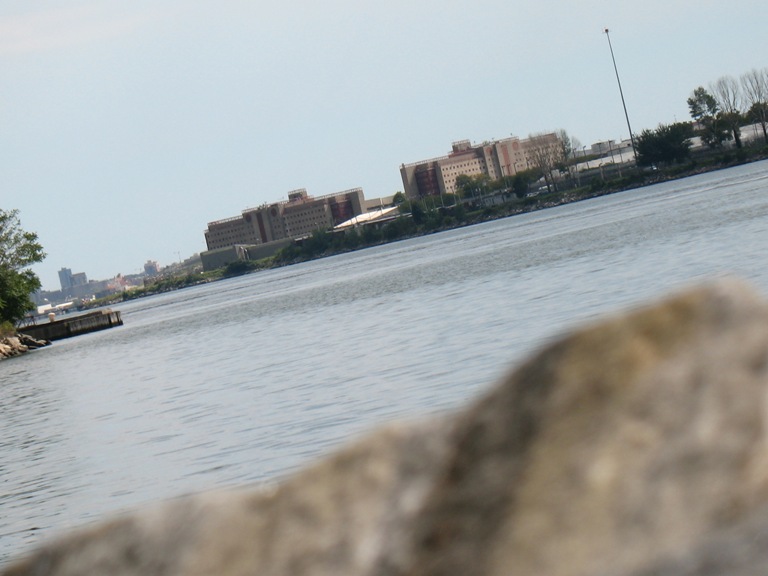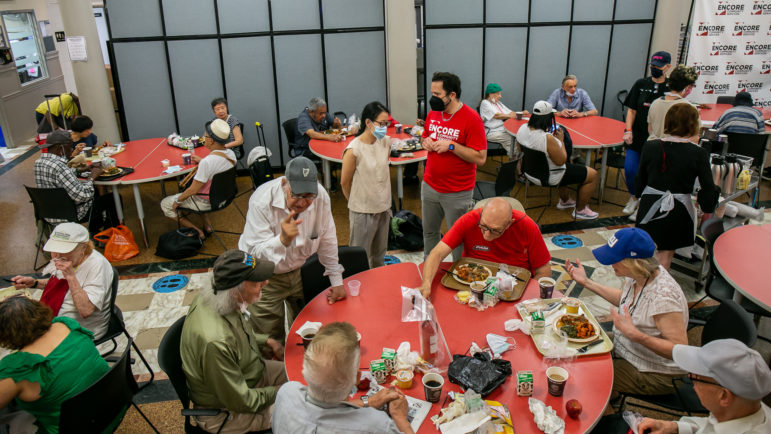‘This month, the mayor announced he will be reopening one of the closed jails on Rikers to accommodate the rising jail population driven by unchecked fear mongering from his police commissioner. This is the wrong move, especially under the horrific conditions in which people are currently being held.’

Jarrett Murphy
Rikers Island.If you haven’t noticed, the climate has been changing around the world. And not for the better. Just last month, flash floods like we’d never seen before stunned our city and cost some of our neighbors their lives. So, in the fight to at least minimize the lethal effects of climate change, we should be changing our policies and practices now. New York City has an opportunity to do just that while also addressing another primary social justice issue in our city—the continued human rights catastrophe that is Rikers Island.
In 2019, after years of organizing by survivors of Rikers and our allies, New York City voted to close ‘Torture Island,’ aka Rikers. In February 2021, we took the next step forward by passing the Renewable Rikers Act—a set of three bills that create a pathway to transition Rikers from its shameful history of incarceration and brutality to hub for green infrastructure.
A key part of the plan is Local Law 16, which requires that every six months, starting July 1, 2021, the city must assess what areas of Rikers Island are not in active use for services to incarcerated people, and transfer them out of the control of the Department of Correction to the Department of Citywide Administrative Services. In fact, the transfer of ownership began this July with the James A. Taylor Center, and will continue until August 2027, when DOC must hand over the island entirely.
I spent 14 months on that decrepit island—an island that was physically expanded to four times its original size by dumping the city’s garbage on it and creating a landfill. It’s an Island that also illegally held free Black men sent there by corrupt judge Richard Riker, who kidnapped them to sell into slavery down South where unfortunately the practice was still legal.
Renewable Rikers will take the soon-to-be-empty land on Rikers Island and transition it to green uses like solar panels and battery storage, composting facilities, and state-of-the-art wastewater treatment facilities. This would help New York City generate our own renewable energy, reduce our carbon footprint, and keep our waterways cleaner, while closing down aging, highly polluting infrastructure like peaker plants that are burdening communities.
 CityViews are readers’ opinions, not those of City Limits. Add your voice today!
CityViews are readers’ opinions, not those of City Limits. Add your voice today!
I experienced not only the ugliness and torture that was created on this land, but also a feeling that legally and morally, Rikers does not belong to the DOC or the city—it belongs to its original inhabitants, the Lenape. When the Dutch and English Settlers arrived in America they began a slow process of raping the land and nature that indigenous people believed and still believe is a part of them, that they are one with. With the greening of this land, and our city, through Renewable Rikers, we can right some of those atrocities the early settlers committed as well as the more recent ones committed by individuals such as Mr. Riker and by our brutal criminal punishment system. Some of the native animals may also return—like some pals for the fat groundhog I used to see next to the Rosie M Singer Center.
But right now, this vision and all its powerful benefits are in danger. This month, the mayor announced he will be reopening one of the closed jails on Rikers to accommodate the rising jail population driven by unchecked fear mongering from his police commissioner. This is the wrong move, especially under the horrific conditions in which people are currently being held. New Yorkers have already decided—we are ending mass incarceration, closing the Rikers Island jails and moving on to a better future. The mayor should close and transfer at least three more jails on Rikers Island before his term ends: GMDC, which is already closed, along with EMTC and OBCC, which were slated to be closed months ago.
Millions of people have been detained at Rikers over the past hundred plus years, tortured and humiliated without provocation, illegally and unconstitutionally held—desecrating the land believed to be sacred by its original inhabitants. Continuing to implement the Renewable Rikers Plan will allow people and the land to heal and flourish.
Eileen M. Maher is a member of VOCAL-NY and the #Justice4Women Task Force.









2 thoughts on “Opinion: Mayor de Blasio Must Act Now to Make ‘Renewable Rikers’ Part of His Legacy”
Yes, Riker’s Ialand has long been a mess, but the idea of moving multiple prisons to inside the city’s burroughs is nuts. So is the ongoing plan to settle homeless people in midtown Manhattan, as now on 40th street on the east side and 38th Street on the west side.
Yes, these people need help and it’s not just food and shelter but often mental health interventions as well. They need to be located in areas where they will not compromise existing neighborhoods in the name of social justice. Bringing people with a history of violenceinto safe neighborhoods is not social justice.
Alan Grassley
Mr. Grassley, there are already smaller borough based jails. I lived across from Brooklyn House for many years and it was never an issue at all. The sheer distance and isolation of Rikers Island has created a midevil system of corruption and violence, both physical and sexual. Most of which is perpetrated by the so called “correction” officers. A mob of poorly trained, poorly educated and psychologically damaged group that is responsible for not only the violence but the trafficking in of weapons, narcotics, tobacco and alcohol. It has also made service providers and services for the detainees much more difficult to arrange and maintain.. Once the Island is closed and placed in areas where this behavior can be investigated more freely and changed you will see an entirely different Detainment System. Services and visits will be coordinated with ease and frequentcy, true investing practices can and will be conducted quicker and with more thoroughly. The opportunity to cover things up will be diminished. And finally the ability for the officers to traffic in weapons, drugs and the like will be much more difficult if not impossible due to the implementation of modern and high quality security systems.
Oh, .p.s everyone knows the safest place to be is near a jail or prison. Seriously.